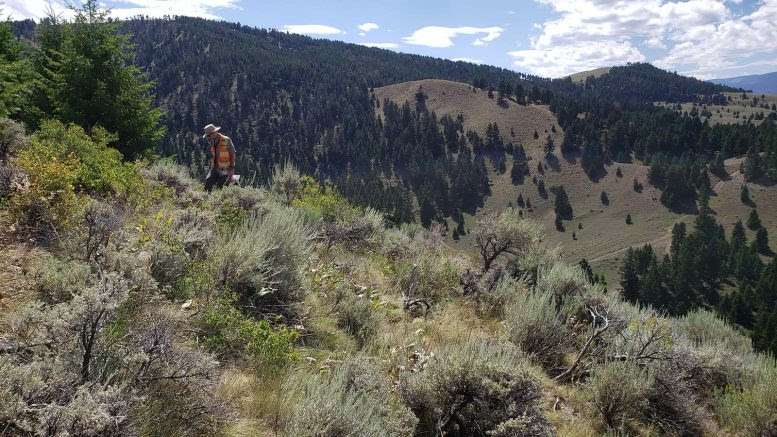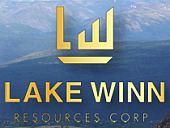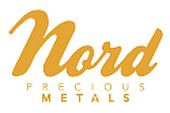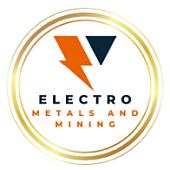 Canada Silver Cobalt – featured in Northern Miner article: Technology Metals Snapshot: Eight companies developing next generation metals
Canada Silver Cobalt – featured in Northern Miner article: Technology Metals Snapshot: Eight companies developing next generation metals
CCW featured in Northern Miner article: Technology Metals Snapshot: Eight companies developing next generation metals
Canada Silver Cobalt was featured as the first company in an article in the Northern Miner July 13, 2022 with the title: Technology Metals Snapshot: Eight companies developing next generation metals.
Technology Metals Snapshot: Eight companies developing next generation metals
 Patriot Battery Metals’ Freeman Creek property. Credit: Patriot Battery Metals
Patriot Battery Metals’ Freeman Creek property. Credit: Patriot Battery MetalsBY: CARL A. WILLIAMS JULY 13, 2022
As economies around the world decarbonize, the increasing demand for electric vehicles and green energy storage technologies is driving a boom in the exploration and development of technology-metals deposits, among them lithium, cobalt, nickel, and rare earths. Here are eight mining companies supporting the global transition to a clean energy future.
CANADA SILVER COBALT WORKS

The Castle mine was one of the highest grade silver-cobalt producers in the historic Cobalt camp in Northern Ontario. Credit: Canada Cobalt Works
Canada Silver Cobalt Works (TSXV: CCW; US-OTC; CCWOF) is a precious and battery metals exploration company with a portfolio of assets that include silver, copper, nickel, and gold discoveries in Ontario and Quebec.
The B.C.-headquartered junior has 14 battery metals properties in northern Quebec. It recently completed a nearly 10,000-metre winter drill program on its 100%-owned Graal-Nourricier-Lac Suzanne (Graal) nickel-copper-cobalt discovery in the Lac St-Jean region of northern Quebec, approximately 160 km north of the city of Saguenay.
Highlights from the drilling included drillhole NRC-22-26, which intersected 5.8 metres grading 0.57% nickel, 0.41% copper, and 0.08% cobalt (0.89% nickel-equivalent) starting from 135 metres downhole, including 0.7 metres at 1.02% nickel, 0.43% copper, and 0.11% cobalt (1.45% nickel-equivalent). That hole was drilled approximately 5 km southeast from an area of massive sulphide mineralization discovered in 2021.
Canada Silver has received all assays from the drill program, which will allow it to move forward with the technical report, according to Matt Halliday, the company’s president and chief operating officer.
“We will continue exploration at Graal to determine the extent of this nickel-copper-cobalt deposit,” Halliday said in a June 27 press release. “This property aligns with our vision of being an important supplier of battery metals for the EV market, and we are excited to see it develop.”
Drilling is testing high-priority anomalies discovered by geophysical surveys recently conducted on the property.
The company is also undertaking an airborne Versatile Time Electromagnetic survey on its Lowney-Lac Edouard property located south of the historical Lac Edouard nickel-copper-cobalt mine in central Quebec. The survey is intended to identify near-surface conductors that will guide field work this summer and provide a better understanding of the area, it said.
Canada Silver also recently discovered a high-grade silver vein system at its Castle East grassroots silver discovery, approximately 1.5 km from its 100%-owned past-producing silver-cobalt Castle Mine project in northern Ontario. The company has completed 60,000 metres of drilling at Castle East aimed at expanding the size of the deposit with an update to the resource estimate underway.
Canada Silver Cobalt Works has a market cap of $20.7 million.
CRITICAL ELEMENTS LITHIUM

The Rose lithium project in Quebec. Credit: Critical Elements.
Critical Elements Lithium (TSXV: CRE; US-OTC: CRECF) is a lithium exploration company with an approximately 700-sq.-km land package that hosts several properties in Quebec.
Headquartered in Montreal, the junior explorer is focused on advancing its 100%-owned Rose lithium-tantalum project in the James Bay region of the province, approximately 40 km north of the Cree village of Nemaska.
The 246.5-sq.-km property is located 80 km south of Newmont’s (TSX: NGT; NYSE: NEM) Éléonore gold mine, 45 km northwest of Nemaska Lithium’s (TSX: NMX; US-OTC: NMKEF) Whabouchi lithium project, and 20 km south of Hydro Québec’s Eastmain 1 hydroelectricity generating plant.
In June, Critical Elements released an updated feasibility study for Rose. The study envisions a 17-year mining operation that will mine a total of 26.3 million tonnes of mineralized material grading 0.87% lithium oxide (Li2O) and 138 parts per million tantalum pentoxide (Ta2O5).
The proposed mill on the property will process 1.61 million tonnes of ore annually to produce an average of 224,686 tonnes of technical and chemical grade spodumene concentrates and 441 tonnes of tantalite concentrate per year from an open pit mine and using conventional lithium processing technologies.
The study estimated the after-tax net present value at US$1.9 billion (using an 8% discount rate) with an internal rate of return of 82.4%. The initial capital cost is estimated at US$357 million.
Critical Elements said that to reflect current market conditions, the feasibility study used conservative spodumene concentrate prices, as well as capital and operating cost estimates (US$4,039 per tonne technical grade lithium concentrate, US$1,852 per tonne chemical grade lithium concentrate, and US$130 per kg Ta2O5).
In May, Critical Elements announced that it had successfully converted spodumene concentrate from Rose into battery grade lithium hydroxide using a thermal leaching process.
Critical Elements Lithium has a market cap of $272.4 million.
GRAPHITE ONE

Inside Graphite One’s facility in Nome, Alaska, with (from left) manager Blake Bogart, Sen. Lisa Murkowski, COO Stan Foo and president & CEO Anthony Huston. Credit: Graphite One
Graphite One (TSXV: GPH; US-OTC: GPHOF) is focused on developing its 100%-owned Graphite Creek graphite project in Alaska’s Seward Peninsula, about 55 km north of the city of Nome.
According to the Vancouver-headquartered junior, Graphite Creek hosts the highest grade and largest known large flake graphite deposit in the United States. It says that graphite flakes from the project will be used to produce high-grade coated spherical graphite for the anodes of lithium-ion batteries.
In June, Graphite One released drill results from its 2021 exploration program at Graphite Creek. The work comprised a total of 2,150 metres drilled between July and October 2021 and included eight core dill holes drilled in areas of inferred resources to upgrade the resource estimate to measured and indicated categories, and nine geotechnical holes.
Highlights included hole 21GC060, which intersected 16.03 metres grading 6.9% graphite starting from 54.17 metres downhole, 18.75 metres of 5.04% graphite from 76.45 metres, and 28.5 metres of 5.13% graphite from 110.5 metres.
The company said the drill results continue to show consistent, near surface high-grade intercepts with numerous holes returning grades greater than 10% graphitic carbon and up to 35.78% graphitic carbon and will be included in an upcoming prefeasibility study for the project.
The deposit remains open downdip and along strike to the east and west, which it said demonstrates the potential for Graphite Creek to become a generational domestic graphite asset.
In April, Graphite One signed a memorandum of understanding (MOU) with Sunrise (Guizhou) New Energy Material Co Ltd., a Chinese lithium-ion battery anode producer. The MOU is intended to develop an agreement to share expertise and technology for the design, construction, and operation of Graphite One’s proposed U.S.-based graphite material manufacturing facility. The facility will be based in Washington State and Graphite One is in discussions with state authorities to determine the facility’s location.
That same month, the company also penned an MOU with battery materials recycler Lab 4 Inc. of Nova Scotia. Under the agreement, Graphite One and Lab 4 will work together to design, develop, and build a recycling facility for end-of-life electric vehicle and lithium ion batteries.
Graphite One has a market cap of $116.1 million.
MASON GRAPHITE

A 3D rendition of the future plant at Mason Graphite’s Lac Guéret graphite project in Québec: Credit: Mason Graphite.
Mason Graphite (TSXV: LLG; US-OTC: MGPHF) is a Canadian mining and mineral processing company focused on developing its 100%-owned Lac Guéret graphite project in northeastern Quebec, approximately 285 km north of Baie-Comeau and 660 km north of Montreal.
In May, the Montreal-headquartered junior entered into an option and joint venture agreement with Nouveau Monde Graphite (TSXV: NOU; NYSE: NMG) to advance Lac Guéret.
Under the deal, Nouveau Monde will have the option to own 51% of the property if it invests $5 million in Mason Graphite and spends $10 million on advancing the property. It would also be required to co-fund a preliminary economic assessment and a bankable feasibility study based on an annual production of at least 250,000 tonnes of graphite concentrate.
Assuming the exercise of the option and formation of the joint venture, Mason Graphite’s and Nouveau Monde’s interest in the joint venture would be 49% and 51%, respectively, and Novueau Monde would be appointed as operator of the joint venture.
In addition, Nouveau Monde has also signed a non-binding agreement with Mason’s subsidiary, Black Swan, to use the latter’s graphene processing technology in its Phase-1 natural graphite flake concentrator in Saint-Michel-des-Saints, Quebec, and to establish a fully integrated facility for graphite ore and graphene-finished products.
The 40-sq.-km Lac Guéret property contains 65.5 million measured and indicated tonnes grading 17.2% graphitic carbon for 11.2 million tonnes of graphitic carbon and inferred resources of 17.6 million tonnes grading 17.3% graphite for 3.4 million tonnes of graphitic carbon.
An updated feasibility study for the project in December 2018 outlined a 25-year mining operation with an annual average graphite production of 51,900 tonnes over the mine’s life. The project is expected to generate an after-tax net present value of $278 million, using an 8% discount rate and a graphite concentrate price of US$1,465 per tonne, and an internal rate of return of 21.7%.
The study pegged the capital investment at $258.2 million and the construction period at about 13 to 16 months.
Mason Graphite has a market cap of $38.2 million.
NEVADA SUNRISE GOLD

Nevada Sunrise Gold’s wholly-owned Gemini Lithium project east of the town of Lida, Nevada. Credit: Nevada Sunrise Gold
Operating out of Vancouver, Nevada Sunrise Gold (TSXV: NEV; US-OTC: NVSGF) is a gold, lithium, copper, and cobalt exploration company and has a portfolio that includes two lithium projects, one gold project, one copper project, and one cobalt exploration project in Nevada.
The junior miner owns 100% interests in the Gemini lithium, Jackson Wash lithium, and the Coronado VMS projects, a 20% interest in the Kinsley Mountain gold project, and a 15% interest in the Lovelock mine and Treasure Box cobalt and copper projects.
Nevada Sunrise’s focus is on advancing its 23.1-sq.-km Gemini property in Esmeralda County’s Lida Valley basin, approximately 10 km east of the town of Lida.
In June, the company announced preliminary results from a 13-line-km Time Domain Electromagnetic survey conducted on the property. It said that initial results from the survey have provided it with confidence for future drill targets within the conductive zones, which have been interpreted as clay layers with potential for hosting lithium-bearing brines.
Nevada Sunrise said conductivity measured to the north and west of two existing drill holes, GEM22-01 and GEM22-02, demonstrated continuity of the zones where lithium-bearing clays and water were encountered.
Hole GEM22-01 intersected 176.83 metres grading 1,203.41 parts per million (ppm) lithium from 97.56 metres downhole, including 91.46 metres of 1,578.19 ppm lithium; and GEM22-02 returned 222.56 metres of 1,101.73 ppm lithium from 118.9 metres, including 39.86 metres of 2,217.69 ppm lithium and 15.24 metres of 3,304.34 ppm lithium.
The company said that it is now amending the existing drill permit for new drill hole locations, which it expects to file this month, and is currently selecting a contractor to start its second phase of exploration, slated to start in the summer/fall of this year.
Nevada Sunrise Gold has a market cap of $14.3 million.
NORAM LITHIUM
Noram Lithium (TSXV: NRM; US-OTC: NRVTF) is a Vancouver-headquartered junior exploration and development company focused on advancing its wholly owned Zeus lithium project in Clayton Valley, Nevada.
The property is approximately halfway between Las Vegas and Reno and about 1.6 km east of Albemarle’s (NYSE: ALB) Silver Peak mine, which is the U.S.’s only lithium producer.
In June, Noram released the final assay results from its sixth drill program on the property. Highlights included hole CVZ-81, which intersected 126.9 metres grading 1.086 parts per million (ppm) lithium from 10.7 metres downhole, including 100.6 metres of 1,169 ppm lithium.
The company said it is now updating the geological/lithium grade models for Zeus and they will be used in an upcoming prefeasibility study for the project.
The grades and thicknesses of the mineralization intercepted by the drill holes are anticipated “to substantially improve the outlook for the Zeus deposit and upgrade approximately 175 million tonnes of the deposit from the inferred resource category to indicated resource,” said Brad Peek, Noram’s vice president of exploration.
A preliminary economic assessment (PEA) for Zeus in December 2021 envisaged a mining operation with a 40-year life producing (once in full production) 245.4 million tonnes of lithium averaging 1,093 ppm lithium over the mine’s life.
The PEA estimated an after-tax net present value of US$1.3 billion (using an 8% discount rate) and after-tax internal rate of return of 31%. The study pegged initial capital costs at US$528 million and an after-tax payback of 3.23 years.
Commenting in the Dec. 8, 2021 press release announcing the findings from the PEA, Sandy MacDougall, Noram’s CEO, said the study “represents the most significant milestone to date for Noram and establishes us among limited peers as the newest low cost, high-grade, near-term lithium producer in North America.”
Noram Lithium has a market cap of $44.4 million.
PATRIOT BATTERY METALS
Patriot Battery Metals (CSE: PMET; US-OTC: RGDCD) is exploring for precious, base, and technology metals and holds a portfolio of properties in Quebec, British Columbia, the Northwest Territories, and Idaho.
The Vancouver-based junior is focused on advancing its 100%-owned Corvette lithium project in the James Bay region of Quebec, approximately 275 km northwest of the Cree village of Nemaska.
Situated within the La Grande Greenstone belt, the 214-sq.-km property hosts significant mineral potential along a 50-km pegmatite trend containing multiple deposit types, including a mineralized trend of more than 20 km of lithium pegmatite outcrops, orogenic gold, volcanogenic massive sulphides, komatiite, and magmatic-hydrothermal deposits.
Patriot Battery has two drill rigs operating on Corvette as part of its summer/fall 2022 drill program. The drilling campaign is expected to include at least 15,000 metres of additional core drilling and will focus on infill and step-out holes at the CV5-1 pegmatite corridor on the property as well as testing regional targets.
To date, nine holes totaling 3,111 metres have been completed with a third drill rig scheduled to arrive in July.
The company has also commenced a surface exploration program on the property, with detailed mapping over the CV5-1 corridor already identifying several new spodumene-bearing outcrops located approximately 150 metres southwest of the CV5 pegmatite outcrops, and approximately 200 metres along strike of the CV3 pegmatite outcrop.
Patriot Battery said that the location of these newly discovered pegmatite outcrops suggests another subparallel trending spodumene-bearing pegmatite may be situated south of the main pegmatite body currently being drill tested.
The current drilling campaign follows-on from a 20-hole, 4,345-metre 2022 winter/spring drill program completed earlier this year. The drilling identified spodumene mineralization over varying intervals in 19 out of the 20 holes.
Highlights included CV22-017. Drilled on the CV5-1 corridor, that hole returned the highest lithium grades yet on the property, intersecting 70.1 metres grading 2.22% lithium and 147 parts per million (ppm) tantalum pentoxide (Ta2O5) from 165.7 metres downhole, including a higher-grade core of 40.7 metres of 3.01% lithium and 160 Ta2O5.
Patriot Battery Metals has a market cap of $211.9 million.
USHA RESOURCES
Canadian explorer Usha Resources (TSX: USHA; US-OTC: USHAF) is focused on advancing its portfolio of early-stage high-grade precious and battery metals projects in North America. These include the Jackpot Lake lithium brine project in Moapa Valley in Nevada, the Lost Basin gold-copper project in Mojave County in Arizona, and the Nicobat nickel-copper-cobalt project in the Rainy River district in northwest Ontario.
In June, Usha announced that it has started exploration work of the recently acquired drill-ready Jackpot Lake. The property, approximately 35 km northeast of Las Vegas, comprises 140 mining claims totalling 11.3 sq. kilometres.
The company said that previous exploration of the property, which included the collection of core and sediment samples, gravitational surveying, geophysical modelling, and controlled source audio magnetotellurics/
Following a site visit by Usha’s technical team, which reviewed drill sites for the construction of access roads and drill pads in preparation for the drilling, permitting for the first drill program on the property is underway, it said.
The company plans to commence drilling in late summer/early fall. The drilling will comprise six holes (2,700 metres) to define an initial resource for the project.
According to Usha, Jackpot Lake is a similar style deposit as Albemarle’s (NYSE: ALB) Silver Peak mine, which has operated continuously since 1996, and Iconic Mineral’s (TSXV: ICM; US-OTC: BVTEF) Bonnie Claire lithium property. A preliminary economic assessment for Bonnie Claire envisions a 40-year mine with an after-tax net present value (using an 8% discount rate) of US$1.5 billion and after-tax internal rate of return of 23.8%.
“With a well-funded treasury, we anticipate the remainder of 2022 to be an extremely active year and we look forward to a busy and productive field season at Jackpot Lake as we also proceed with our other catalysts including the Nicobat Nickel spinout,” said Deepak Varshney, Usha’s chief executive, in a June 22 press release announcing the planned exploration program.
Usha Resources has a market cap of $10 million.




























